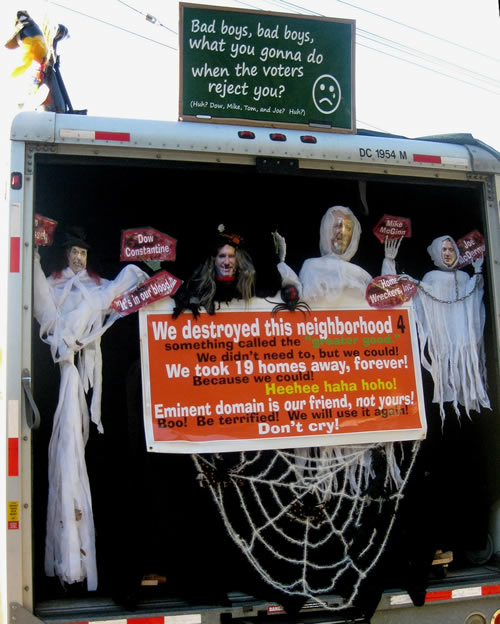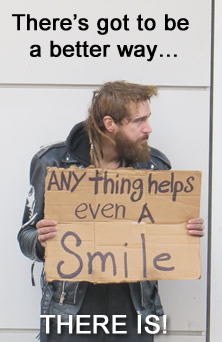Search this blog






Recent Comments
- Seattle: The Entitlement City™ (2)
- Taking Back Harm Reduction (1)
- Jeana Bartucci { The frequency of friends, but ESPECIALLY parents, calling my coworkers and supervisees at work for things that aren’t emergencies absolutely floored me when I started... }
- Homeless, Inc. Lady Makes Bank (6)
- Shaun { Everywhere that I can only leave a comment about this organization I'm going to leave a comment the description they have given the community is... }
- Health insurance: Why is this so damn hard? (5)
- Dick Kraske { Take a look at the rap sheet that the w/WA sT Insurance Commission has on Regence Insurance. One fine for $750,000 plus more violations can... }
- Older »






Log-in, etc.





Intellectual Dishonesty
Intellectual dishonesty is when someone catches you out in a misstatement or fallacious argument but you refuse, in spite of the evidence, to admit you were wrong. That’s what happened here, with a Facebook post from Occupy Democrats.
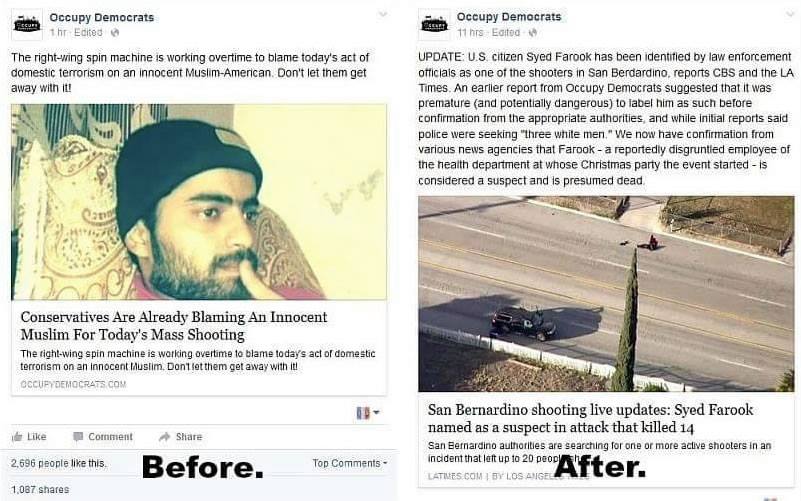
The Before and After view of Occupy Democrats’ take on the San Bernardino shooting.
[Click to enlarge the image.]
When OD’s claims turned out to be false – read an in-depth New York Times story on the shooters here – they took down their post. However, they did not issue a retraction. Instead, they changed their tune, claiming that in the first post they were merely concerned about a presumption of innocence. But the way I read that first post – which is how I think any reasonably objective person would read it – is that OD mostly wanted to embarrass conservatives, whom they had already decided were guilty of Muslim-bashing. So much for the presumption of innocence.
I contacted Occupy Democrats on December 6, 2015, asking for comment. They did not respond. Their e-mail is OccupyDems@gmail.com if you’d care to send them a note on this or just to let them know you read this story.
–David Preston
Posted in Media, Politics
Tagged intellectual dishonesty, Occupy Democrats, San Bernardino
Leave a comment
Reducing Homelessness: Now you’re talking
Seattle Times (Around the Northwest)
Friday, December 11, 2015
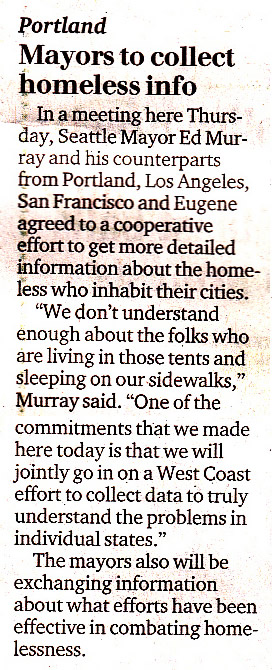 This story indicates a move in the right direction for Seattle and other large West Coast cities. Hopefully, demographics on homeless people who wind up in these cities now be collected to determine how homeless people move from one place to another. These are some of the questions that can be answered after the data is collected:
This story indicates a move in the right direction for Seattle and other large West Coast cities. Hopefully, demographics on homeless people who wind up in these cities now be collected to determine how homeless people move from one place to another. These are some of the questions that can be answered after the data is collected:
► What percentage of homeless people in these cities moved there from somewhere else? How likely is someone to move after he becomes homeless?
► What percentage of homeless people are drifters? Why do homeless people who move from place to place choose one city over another?
► Do many people become homeless as a direct result of moving one place to another, and if so, what are the contributing factors?
► Are some cities and towns doing more than others to help homeless people. Are some states doing more than their share? If so, do they become homeless magnets?
With the answers to these questions in hand, public officials in Seattle can finally begin to determine why they aren’t making any headway in reducing homelessness in the city. I believe the data – if it is collected scientifically and studied honestly – will show that Seattle and a handful of other cities have, through well-intended but unsound policies, become magnets for the homeless and perpetuators of homelessness.
Posted in General, Homelessness, Nickelsville
Tagged Ed Murray, homeless policy, homelessness, Seattle Mayor
Leave a comment
Victim Culture

This soundbite by comedian/social critic Louis C. K. demonstrates the fallacy upon which many claims of harm have foundered. The reason the fallacy persists is because the basic idea has some truth in it. When a person tells you you’ve hurt them, you really don’t get to decide that they’ve not been hurt, because how would you know? By the same token, they don’t get to decide that YOU hurt them (as in, hurt them on purpose) because how would THEY know? That’s where the fallacy lies, in the confusion between action and intention.
Victim culture starts from the reasonable and demonstrable premise that people get hurt and proceeds to the false conclusion that, for every act of hurt, there must be someone who deliberately caused it. When a victim can’t find a specific individual to take the blame, he looks for an unspecific group or institution. Like a corporation, for example. Or maybe the whole capitalist system. Or modern technology. The government. Feminism. Slavery . . . The inducement to blame an institution for one’s hurt rises in proportion as the institution (a) has a proven record of misdeeds, or (b) has money with which to compensate victims, or (c) is simply unable to defend itself.
You can’t sue feminism, for example, so there’s no monetary inducement there. But neither can feminism rise to defend itself from your specific claims. Therefore, feminism makes a nice scapegoat for your various hurts, or your general dissatisfaction with life.
Corporations can defend themselves, so there’s some risk and hassle there. And the jackpot at the end of the rainbow is accordingly larger. Did someone (maybe you, maybe your server, who cares) bobble your coffee at the drive-up and scald you? McDonald’s doesn’t get to decide that you didn’t get scalded, do they? You’re injured, by God and someone’s gotta pay for that. McDonald’s can afford it, so why the hell not?
When someone tells me I’ve hurt them, I say, I’m sorry you’re hurt. –I acknowledge their feeling; I don’t dismiss it. But neither do I immediately accept the blame for it. Instead, I ask myself: What WAS my intention here? Should I have seen the hurt coming? Is there something I could’ve done to prevent it? –If it turns out that I am at fault, I apologize for my blunder, try to soothe the hurt, and move on. But if not, I don’t acknowledge that there is any fault to be assigned, and I don’t apologize. In my experience, apologizing for hurts I did not cause has never turned out well.
–David Preston
Posted in Essays, General, Politics
Tagged blaming, Louis C.K., political correctness, victim culture, victims
Leave a comment
The Friends of Kshama Sawant: Progressive politics and influence at City Hall
November 13, 2015 ~ Seattle
A “People’s Budget Town Hall”
Late last month, one week ahead of city council elections, Seattle City Councilmember Kshama Sawant hosted her second “People’s Budget Town Hall” event at City Hall. Cleverly disguised as a public forum and panel discussion, this meeting was essentially a pep rally for Sawant. The roster included speakers on housing, taxes, and a number of other of Sawant’s pet causes. Before the event a Sawant staffers named Ben walked around the room handing out summaries of his boss’s proposed 2106 budget amendments. Looking over the list, I noticed that it roughly corresponded with topics the panelists would be discussing. Sawant is trying to raise taxes on business and the wealthy, for example, and there was a corresponding “Progressive Taxation” item on the agenda. Sawant proposes to build a LGBTQ community center, and there was someone from a local LGBTQ group speaking to that, under the heading of “Racial Justice.” And so on. Needless to say, these are popular topics in Seattle right now. And particularly so with Ms. Sawant’s constituency.
Here’s the complete list of Ms. Sawant’s budget amendments (two pages):
Sawant_BudgetEthical Issues
Is it ethical for a councilmember to have a publicity event at City Hall just a week before the election? I asked the Seattle’s Ethics and Elections Commission about this, and they told me they’d already deliberated the matter a few months earlier, in response to a formal complaint about another Sawant rally. The Commission determined that there’s no rule that expressly forbids such use. Read the Ethics Commission’s summary here.
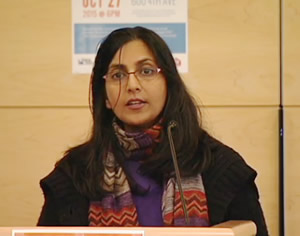
Kshama Sawant introducing a speaker at her “People’s Budget Town Hall” event.
Image: Seattle Channel
Most of Sawant’s panelists also had something to gain from her too, beyond just an opportunity to put their various causes in a good light. One speaker was an organizer for Sawant’s political action committee Socialist Alternative. Another worked for YouthCare, a Seattle-based non-profit that gets hundreds of thousands of dollars in Seattle taxpayer money yearly. There were 13 panelists all together, and the majority of them had some financial connection either to Sawant directly, or to the city.

Two panelists that I was particularly concerned about were Sharon Lee and Jarvis Capucion. Ms. Lee is CEO of a powerful non-profit corporation called the Low Income Housing Institute (LIHI); Mr. Capucion is an employee of the Seattle Housing and Resource Effort (SHARE). Between them, these two groups get over a million dollars in city contract money each year. And these contracts are funded by Ms. Sawant and her colleagues on the Council, through the budget process.
SHARE and LIHI are connected through a man named Scott Morrow. Morrow’s mother founded the SHARE organization and he currently runs it. He also co-founded LIHI in 1991 and still influences it through his association with Ms. Lee. In recent years, Lee and Morrow have collaborated on several projects. LIHI hosts fundraisers for SHARE, for example, and rents “emergency shelter” space to the group, also funded by Seattle taxpayers. Lee has also co-sponsored Morrow’s “Nickelsville” homeless camps, which are also funded partly at city expense. At first flush, Morrow would appear to be the junior partner here, since his SHARE group is tiny and has little property. Contrast this with Lee’s group, which has multi-million-dollar payrolls and controls hundreds of millions of dollars in real estate. Morrow is a rather unsavory character himself. Local media paint him in sinister tones, characterizing him as a kind of Godfather of the shelters and tent camps he runs. Bad as Morrow is, Ms. Lee stands ever ready to do his bidding. If Morrow needs a place to move one of his camps, Lee is right there with a piece of empty property. If Morrow needs a place to put a couple hundred people for the winter, Lee offers some warehouse space. All paid for by the taxpayers, of course. With the money going . . . somewhere. (Two years ago, when I asked Ms. Lee’s to show me where the money went, she didn’t respond.)
Now Ms. Sawant is stepping up to help Mr. Morrow, too. Curious.

Sharon Lee and Scott Morrow discuss strategy at the “People’s Budget Town Hall” event.
Undue Influence?
There were several members of Morrow’s SHARE group in attendance at the event and there was a stack of fliers at the door supporting Sawant’s call for rent control and claiming that SHARE needs $250,000 in the next budget. [Click here to see the SHARE flier.]
Ms. Sawant’s relationship to Ms. Lee and Mr. Morrow is particularly troubling for anyone who has experience with Morrow’s Seattle homeless camps. In January of 2015, residents of the Nickelsville camp at South Dearborn Street tried to vote Morrow out for reasons that will probably never be known. [That story here.] Morrow told the residents that if they didn’t accept his control of the camp, they’d have to pay him for $12,000 worth of bills he’d incurred on their behalf (port-a-potty servicing, trash pick-up, etc.) If the campers didn’t pay up, Morrow told them, they’d have to go back to the streets. In the middle of winter.
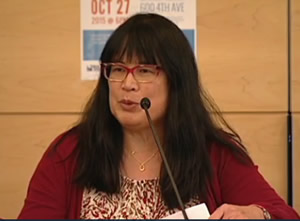
Sharon Lee speaks to the crowd about affordable housing and urges people to support of Ms. Sawant’s budget amendments. Amendments that will also benefit herself and her organization. When I asked Ms. Lee (via certified mail) to discuss her role in the threatening homeless campers she did not respond.
Image: Seattle Channel
Ms. Lee, who also claimed to be paying some of the camps bills, seconded Mr. Morrow’s ultimatum. That still wasn’t enough to intimidate the campers, but when the church that was nominally sponsoring the camp threatened to pull its support, the campers relented and voted Morrow back in. The troublemakers were then removed from the camp and a slander campaign was begun against them. [Read more here.]
I separately asked both Morrow and Lee (see below) to give me an accounting of what bills they’d paid for the camp. They did not respond. Later, as part of my efforts to persuade the Seattle Human Services Department to establish a grievance process for campers, I discovered that the City itself had paid for Nickelsville’s expenses, though they claimed that they did this AFTER Morrow made his threats against the Nickelsville camp. In any event, the homeless people at Nickelsville were never under any legal obligation to pay Mr. Morrow’s bills, and so Mr. Morrow and Ms. Lee should not have used that as a cudgel with which to force them to accept Morrow’s control.
Request-to-Sharon-Lee-8.11.15On October 6, 2015, I e-mailed Ms. Sawant asking her to meet with me about the situation at Nickelsville. [Read my request to Sawant here.] She did not respond. Later, when I saw both Mr. Morrow and Ms. Lee represented at the People’s Budget Town Hall, I understood why I was getting nowhere with Sawant. Sawant has political and business relationships with these two people: they give her good press and speak at her meetings, and in return, she runs political interference for them and helps make sure the contract money keeps flowing. Given this symbiotic relationship, how likely is it that Sawant would listen to my criticism of Lee and Morrow, or the organizations they control?
To be fair, I should note that I contacted two other councilmembers and asked to discuss the problem of shielding homeless campers from retaliation. One councilmember, Bruce Harrell, didn’t respond to me. Another, Mike O’Brien, said he thinks everything is fine at the camp and campers don’t need any special protections. O’Brien is another one of Mr. Morrow’s helpers. He has quite a few of them on the Council, actually; Ms. Sawant is merely the latest addition to his stable.
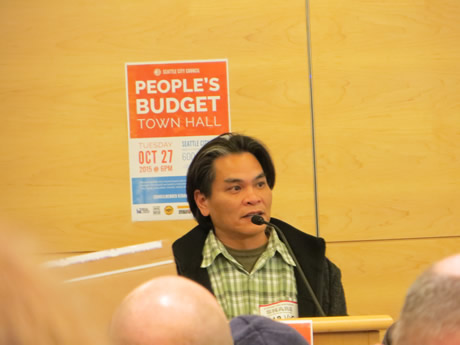
SHARE employee Jarvis Capucion speaks in favor of Kshama Sawant’s budget demands, which include [wink] a demand for an additional $250,000 in taxpayer money . . . for SHARE.
Different rules for socialists?
Last year Ms. Sawant pointed the finger of shame at councilmembers for attending a Chamber of Commerce-sponsored retreat at taxpayer expense [story here]. She was right to do that. We don’t want groups that do business with the City to have pets on the Council. Yet for all her scolding of others, she seems quite content to be someone’s pet herself . . . as long as that someone has a progressive tinge and is willing to cheer on her socialist cause. Perhaps, in her view, anyone who claims to be helping the downtrodden is above suspicion. But in my experience it’s always the ones who are above suspicion that you’ve really got to watch.
–David Preston
Here is the full Seattle Channel video of the People’s Budget Town Hall:
For more info about the cozy relationship between Scott Morrow, SHARE, and City Hall, see the Lisa Herbold story here.
For another story about how Ms. Sawant influences politics in Seattle, see my Outrage on Demand story.
Posted in General, Homelessness, Nickelsville, Politics, SHARE
Tagged affordable housing, bruce harrell, Jarvis Capucion, Kshama Sawant, LIHI, Lisa Herbold, Low Income Housing Institute, progressive politics, Scott Morrow, Seattle City Council, Sharon Lee, socialism, Socialist Alternative
3 Comments
Lisa Bright and Dark
Lisa Herbold is the presumptive new Seattle councilmember for my district. Her campaign platform is that she works for the little people (just like Kshama Sawant) and that she’s not for sale to corporations. She might not be for sale, but that doesn’t mean she’s not for rent.
 Two years ago I had some interaction with Ms. Herbold. The manager of a large and problematic homeless camp in my neighborhood was refusing to meet with the city about finding a new place to stay. The camp had been in the same place nearly two years and everyone agreed that it was time for them to move on, but the camp manager insisted he wasn’t budging until the City found him a place at least as good as the one he was at. Many people in the neighborhood were getting tired of all this, however. The camp was on public land (illegally) and the City had many tools at its disposal to resolve the situation, but there was a political stalemate caused by political cowardice and a lack of imagination.
Two years ago I had some interaction with Ms. Herbold. The manager of a large and problematic homeless camp in my neighborhood was refusing to meet with the city about finding a new place to stay. The camp had been in the same place nearly two years and everyone agreed that it was time for them to move on, but the camp manager insisted he wasn’t budging until the City found him a place at least as good as the one he was at. Many people in the neighborhood were getting tired of all this, however. The camp was on public land (illegally) and the City had many tools at its disposal to resolve the situation, but there was a political stalemate caused by political cowardice and a lack of imagination.
I e-mailed and called Ms. Herbold and her boss Councilmember Nick Licata repeatedly over several weeks, but they didn’t respond . . . until I threatened to embarrass them publicly. When I finally got a call from Mr. Licata, he told me that he couldn’t do anything to force the homeless camp owner into talks, but he did agree that the City would participate if I could set something up informally with the other stakeholders, which included the homeless camp manager and a local neighborhood group. Fair enough. I got the neighborhood group to buy off on having a meeting. But then camp manager refused to participate, so nothing came of it. (It took the city another year to evict this guy from the property, and when he finally went, he left a huge mess to be cleaned up at taxpayer expense.)
Some months later, after I first contacted Ms. Herbold, I heard through the grapevine that she had had a previous “relationship” with the manager of the homeless camp, a guy named Scott Morrow. So I e-mailed and asked her: Did you know this guy from the time before you worked for the City Council? First she said, No. So I got right back to her and said: Think hard. Because I’ve heard that you used to work with him.
So then Ms. Herbold came back and said (paraphrasing), “Yes, well, looking back I remember that I did work on some projects with Scott when we were at the Tenants Union together.”
A few weeks after that, when I was reviewing a complaint filed against Mr. Morrow’s organization with the Seattle Office for Civil Rights, I came in contact with a formerly homeless woman who said she was evicted from one of Mr. Morrow’s tent camps for refusing to go to a political demonstration on Morrow’s orders. The woman told me that, before being evicted, she had complained to the City Council and her complaint was forwarded to Ms. Herbold. Ms. Herbold asked the complainant if it was alright if she (Herbold) contacted Morrow about it. The complainant gave her permission. Herbold then called Morrow, and shortly thereafter the complainant was evicted from Morrow’s camp. (!) The complainant told me that after Ms. Herbold talked with Mr. Morrow the pressure on her at the camp ramped up significantly. At that point, when Ms. Herbold asked the complainant if she could do anything else, the complainant told her: No. Please stay out of it. You’re not helping, you’re hurting.
I believe that Ms. Herbold did not apply any pressure to Mr. Morrow to get him to do the right thing. And she never will, because she considers him a friend, and you just don’t side with strangers against your pal. I have seen pictures of Herbold at fundraisers for Morrow’s non-profit organizations, pictures that should be very troubling, consider Morrow’s dependence upon taxpayer money. Morrow’s non-profit groups – that is, the ones he controls directly – get hundreds of thousands of dollars in city funding every year. And the ones he controls indirectly, through intermediaries, get far, far more. I don’t know exactly what the relationship is between Herbold and this money, but you can bet there is one. You just to have to do a little research and connect the dots.
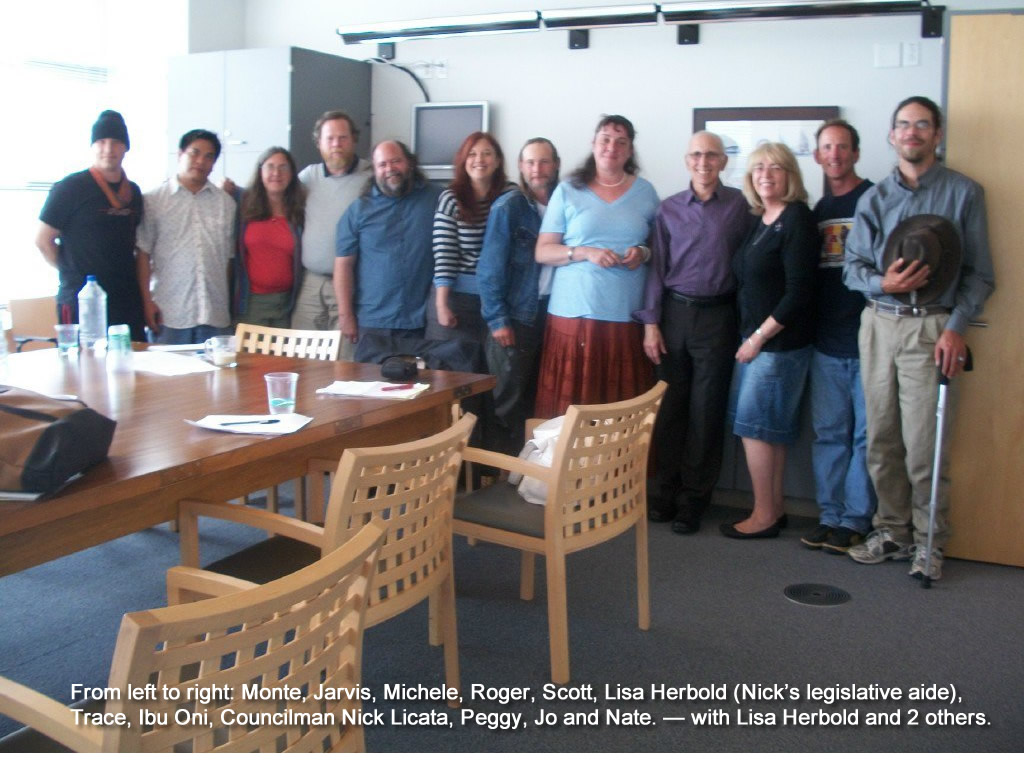
Scott Morrow and Lisa Herbold during a recent meeting at City Hall. Also in attendance are Councilmember Nick Licata and several of Mr. Morrow’s employees at SHARE. [Click photo to enlarge.]
Ms. Herbold is aware of all these goings on with Mr. Morrow and his camps. I cc’d her on several of e-mails to Human Services and have sent her links to numerous stories that I’ve posted on my personal blog. But of course I never hear back from her, and nothing ever changes. If anything, matters are now likely to get worse. After being elected to Nick Licata’s old job, Ms. Herbold will have even more power to help Mr. Morrow. And there’s no reason to think she won’t.
–David Preston
Outrage on Demand: How Seattle’s Kshama Sawant packs ’em in at the Seattle City Council
On October 6, I was treated to something I’d never seen in 27 years of following Seattle politics: Paid shills drumming for a councilmember during an official meeting. It was at a public hearing on budget priorities. Twenty minutes in to the public testimony, a woman named Jess Spear from Kshama’s Sawant’s “Socialist Alternative” group stood up, gave a plug for Sawant, and proceeded to condemn the Council for being corporate stooges and not getting in line behind Sawant on the minimum wage, higher corporate taxes, and so on. When Ms. Spear’s time was up, another member of Socialist Alternative stood up and went through a similar routine, giving Sawant a kudo and angrily criticizing the rest of the council for being slow to take up the cry on her program.
And then another Sawant fan stood up. And another. And another. And another.
Six of Sawant’s people in all spoke to the Council that evening, their testimony consuming a good part of time that was allotted to the public (by which I mean the REAL public). As the shills did their thing, Sawant gloated while the other councilmembers cowered in fear. The message was not lost on them: Cross Sawant and you can expect trouble.
Shortly after she was elected, Ms. Sawant announced that she would be donating half her salary to charity. It sounded like a noble gesture, but when I learned that the charity Ms. Sawant would be favoring was her own political pressure group, the glitter faded. And then, when I went to this meeting and saw just what the Sawant organization was up to, I got downright queasy.
Is this socialism? I wondered. Using hired muscle to intimidate the opposition in a council meeting?
Socialism or no, I’ll tell you one thing . . . it’s not democracy.
–David Preston
Posted in General, Politics
Tagged 15 now, Kshama Sawant, Seattle City Council, socialism, Socialist Alternative
2 Comments
Whitewash-Dot-Com: How the Internet sanitizes SHARE
Readers of this blog will recall that I devote some of my time to discussing how journalists are manipulated – sometimes with their own connivance – by non-profit organizations and others who stand to make a buck from good publicity. This is a symbiotic relationship for all parties involved: Editors get good copy, readers get a warm fuzzy feeling, and the non-profits get donations.
Cracked.com is a leftist political commentary and satire site. I won’t smear it with the term “journalism” – though some of its readers seem to think it is just that. Hipster journalism. Last month, a friend of mine, knowing of my interest in all things fishy, pointed me to a piece Cracked did on one of the Nickelsville homeless camps in downtown Seattle. I was particularly interested to read it, since I am familiar with the camp and some of the events described in the article. I have covered some of them extensively on TBQ. Here it is: Cracked.com: 5 Horrifying Things
In late January 2015, there was a failed palace coup at Nickelsville, in which the camp residents attempted to vote the non-resident camp boss, Scott Morrow, out of his position. Those events are recounted, seven months later, to Cracked author Robert Evans by an inside source named Heather:
But let’s not pretend that several dozen destitute addicts will spontaneously form a utopia. For instance, several former Nickelodeons spoke of an infamous coup by a meth-smoking clique that once took control of the camp. According to Heather, a former resident, “There were new people, and the new people that came in all voted together and took the top three positions.” This new ruling clique successfully banished their opposition from the camp like Mad Max Beyond Thunderdome. They spent several happy days smoking meth in their tents and ruling Nickelsville, until the land owner threatened to kick the whole camp off his property, which would have seriously (and maybe permanently) fucked up a lot of people’s only place to stay.
I think I know this Heather, but more on that in a bit. For now, let us compare Heather’s account with a more contemporaneous account of the same event in the Seattle Times:
Anthony Jenkins and Lisa Hooper, two current Nickelsville residents, said they voted against [camp manager Scott] Morrow because he had been threatening to take away resources, such as portable toilets, over a disagreement. Remaining residents are in talks with a different church and are hoping for an opportunity to operate Nickelsville themselves, Jenkins said.
“We just want a chance,” said Hooper, sitting inside the encampment’s tent kitchen Friday. “We can do this effectively.”
 Note how the Cracked source, Heather, does not say anything about Mr. Morrow in connection with the palace coup. She does mention Morrow later in her remarks (see below), but in a very different context. Unfortunately, even the Times piece doesn’t tell us the nature of the “disagreement” between Morrow and the Nickelsville residents, the squabble that Morrow allegedly used as pretext for taking away the camp’s portable toilets.
Note how the Cracked source, Heather, does not say anything about Mr. Morrow in connection with the palace coup. She does mention Morrow later in her remarks (see below), but in a very different context. Unfortunately, even the Times piece doesn’t tell us the nature of the “disagreement” between Morrow and the Nickelsville residents, the squabble that Morrow allegedly used as pretext for taking away the camp’s portable toilets.
Back to Heather’s version of the coup: that it was just a few meth-smokers trying to take over. It seems unlikely that a few drug-addled cronies would have the wherewithal to force the 60-plus residents to bend to their will. And it beggars belief to claim that such people would be willing to meet with a Seattle Times reporter to discuss the matter at length. I would have liked to hear Mr. Morrow’s response to Jenkins and Hoopers’ charges against him, but Morrow was not asked this question by the Times reporter, and when I tried to contact him myself, he did not respond.
After being voted out of camp, Morrow and his cronies (including the pastor of the sponsoring church and the CEO of a large non-profit housing group) threatened the entire camp with a hasty eviction, claiming that the campers owed Morrow’s non-profit some $10,000 for expenses they had accrued. The campers then promptly reversed their vote and the anti-Morrow people were presumably expelled.
The Scoop on Scott Morrow
The Cracked.com piece does refer to Scott Morrow, but in a much different connection. At the end of the article, in a discussion of moving the camp to a new location, Cracked describes Morrow as a “former resident” and “a homeless person who’s moved on” (see below). In fact, Morrow has not moved on from homelessness, because he’s never been homeless. He is the long-time boss of the downtown Seattle Nickelsville and two other homeless camps in King County, as well as several small shelters around Seattle. He controls two housing non-profits that between them take in well over a million dollars in taxpayer funding and private donations each year, and he has influence over a third organization he co-founded in 1991, the Low Income Housing Institute, that controls tens of millions of dollars worth of prime real estate in downtown Seattle. (The CEO of LIHI, a woman named Sharon Lee, came to Morrow’s aid during the January 2014 power struggle at Nickelsville. She claimed that the campers owed her money too, and if they didn’t accept Morrow as camp boss, they’d have to scram.) Morrow has longstanding political connections in government, going all the way up to Washington state’s powerful Speaker of the House, Frank Chopp. Yet to hear Cracked.com tell it, he’s just another ex-homeless dude who has stuck around to help. Out of gratitude, presumably:
And, as with everything else, the logistics of these [periodic homeless camp relocations] are worked out by volunteers, usually current and former residents. In the case of Nickelsville, it’s a former resident named Scott and his partner, Peggy.
According to Heather, “They would search for the places, set up fundraisers, do paperwork. They would do the things that nobody else could do.” Scott has, in fact, been organizing the moves and finding Nickelsville new land for something like 20 years. He hasn’t been homeless for most of that time, either. Scott and Peggy are two who moved on, improved their situation, and decided to keep trying to make a difference.
The Peggy mentioned above is Peggy Hotes, a retired school teacher who owns a home in the pricey Seattle exurb of Bellevue. Hotes co-manages Morrows constellation of homeless camps. Like Morrow she has never been homeless herself.
Setting Things Straight
The claim that Morrow and Hotes are formerly homeless people who have “moved on” is simply not true. Heather’s characterization of Jenkins and Hooper as meth-heads is a slander, and Cracked.com’s failure to mention Morrow’s actual role in the power struggle of January and the camp at large is either some of the world’s laziest reporting (I won’t dignify it as journalism) or a deliberate misrepresentation. I contacted the author, Robert Evans, and filled him in on the background to the Nickelsville rebellion, inviting him to follow-up with me for more details. I sent him the link to the Seattle Times story and suggested that he either pull the Cracked article or do a clarification. He didn’t respond and, as we see, his article is still up there, without any addenda.
If you’d like to contact Mr. Evans, his e-mail is Revanswriter@gmail.com. Tell him The Blog Quixotic sent you. While you’re at it, ask him if he actually visited the camp.
Summary
Despite its patented uber-satiric hipster tone, the Cracked.com article on Nickelsville is likely a either a full-on plant or a manipulation. And when I say manipulation, I mean in the sense that Mr. Evans was vetted and his access to the camp was controlled to ensure that he saw and heard (and wrote) only what camp boss Morrow wanted him to. Think of a mainstream media correspondent “embedded” with the troops in Iraq. The stories these reporters fed to their editors may have felt authentic to viewers back home, but they were little better than Pentagon press releases.
The Cracked.com piece has all the earmarks of a fake story generated to polish SHARE’s image:
- The inside angle (“Here’s the down-low on homeless people. The inside story.”)
- The role of Scott Morrow and SHARE is ignored or obscured
- The neatly resolved tension (“It was just some druggies trying to take over.”)
- An image of the homeless camp as a kind of family, complete with kids
- The conclusion that homeless camps are self-managing, democratic, and safe
- A link to a donations page at the end ↓↓↓

Whether the Cracked piece is an out-and-out plant, it’s certainly not an objective or in-depth look at the complex and multi-faceted problem of homelessness. It’s too bad that thousands of people will come away from this story thinking they now know more about homelessness than they did before. When in fact they know less.
–David Preston
Postscript: A word about “Heather”
I believe I know the Heather who helped Cracked.com write their story. I met her in the Nickelsville camp at Marginal Way in the summer of 2012 and worked with her on a writing project about her experience as a homeless person. That Heather was an articulate and engaging person, but it soon became clear to me that she suffered from untreated psychosis. She had paranoid delusions of people both in and out of camp plotting against her. Months later I saw Heather on TV, glassy-eyed and stiff, testifying on behalf of Nickelsville at City Council meetings. Seeing her like that, I understood how easy it would be for someone to manipulate her. Here was this young woman: homeless, sick, and frightened out of her wits. How hard would it be to plant a narrative (“the rebels were a bunch of drug addicts”, “Nickelsville needs more money”) into the mind of someone like that and then have them spout it back out on cue?
Where in the World is Monica Spain?
Reading the Cracked.com love letter to Nickelsville reminds me of another faux news story that came out about two years earlier. That piece was penned by someone working for SHARE (probably Peggy Hotes) and then distributed to a Seattle news outlet under the pseudonym “Monica Spain.” When I asked the news director to hook me up with the Ms. Spain, she refused, citing privacy issues. Hm. A journalist with a wacky name and no return address. Sounds legit . . . Story here:
Posted in Homelessness, Media, Nickelsville
Tagged Cracked, Cracked.com, Dan Beekman, David Preston, Dearborn, frank chopp, Nickelsville, Robert Evans, Scott Morrow, Sharon Lee
2 Comments
Homeless Are Taking Over (Literally)
A recent story from the Seattle Times illustrates the mess a city can get into when it tries to be nice and doesn’t ask too many questions. Take homelessness for example. In spite of all our self-guilting, Seattle has a braggable record when it comes to helping homeless people. There are thousands of nightly shelter beds here, and tens of thousands of low-income and subsidized housing units. And yet, as we see in this story, Seattle still has a problem with street people. The City is on the hook for clearing and/or arresting the squatters. But note that it’s the building owner, not the City, who must pay for the damage to the building and premises. Beyond that, the owner could be fined (up to $1,000 a day) for failing to keep people out of the building.
Article: Former Seattle Times Building Now Home to Thieves and Squatters

Squatter damage at the old Seattle Times building. (Photo: Seattle Times)
The owner couldn’t be reached for comment Wednesday. But Eric Guisasola of CG Construction, whom the owner hired to secure the building, said he and co-workers have been trying to secure it unsuccessfully for about a month. “It’s a nightmare,” he said. “They throw things at us.”
Guisasola said there are actually two separate groups of people who were in the building: the homeless and professional thieves.
Curiously, the problem is much worse in Seattle than it is in smaller cities like, say, Spokane. Why should that be? Are the homeless of Spokane coming here on purpose? Is Spokane that much worse to be homeless in? Or is Seattle perhaps doing something that attracts homeless folks?
Unfortunately, we don’t know the answers to these questions, because city officials in Seattle, from the mayor on down, haven’t asked. For all the public hand-wringing and all money the city spends on low-income housing and shelter programs (around $100 million per year) Seattle has not done a single study to see whether we’re doing more or less than our share relative to smaller communities around the country. Nor do we know if Seattle government policies might actually be enticing people to give up their homes in other places and take their chances on the street, here.
Meanwhile, the throng of homeless on our streets grows, and when they become desperate enough, they start taking other people’s stuff. If the situation continues to decay, it could lead to a harsh government crackdown or even vigilante actions.
Don’t scoff. It’s happened before. For all the lofty talk about social justice you’ll find that when it comes to property rights, even the beautiful people can get ugly.
Posted in Homelessness, Media, Photos (People), Politics, Squatters
Tagged homelessness, Occupy, seattle times, squatters
2 Comments
Homeless Camps: Do they get people off the street?
Do homeless camps really get people off the street? Or do they merely concentrate them in one place? One thing is for certain: The camps do attract homeless people. And not all of those people are actually in the camp. Many of the folks who turn up in the vicinity of a camp have chronic problems with addiction, mental illness, and problem behaviors. These people are not likely to be receiving whatever social services are available to the nearby campers, and they are not subject to whatever rules of behavior may prevail within the boundaries of the camp itself.
The pictures below were taken in late August, 2015. They were taken at the Nickelsville homeless camp at 1010 S. Dearborn Street in Seattle and vicinity. All photos were taken within a hundred-yard radius of the camp.
First: The camp itself.

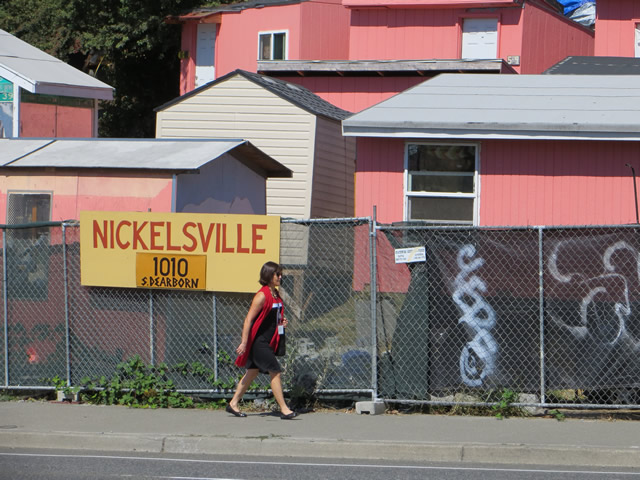
Now the surrounding area . . . Several people have pitched tents in the greenbelt nearby. This person found a niche at a freeway overpass adjacent to the camp.
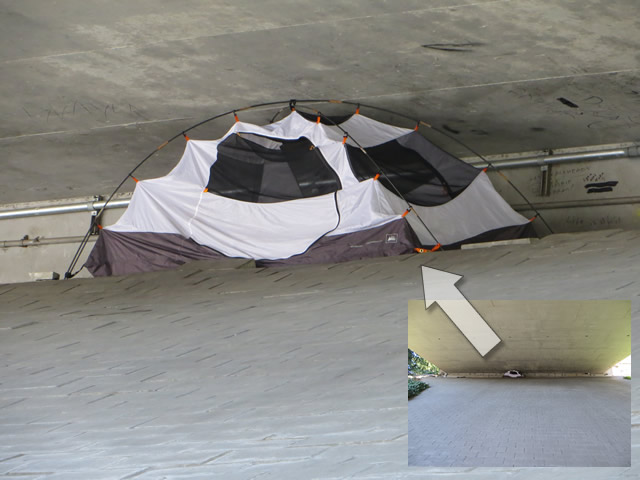
Someone is living out of these boxes . . .

This man seems to have a complete pantry. While I was there, I saw him get up and stagger about. He was clearly either intoxicated or disabled. The embankment is some 30 feet above the street level and has a very steep grade, with no barrier between the sidewalk and the nearby traffic. One wrong move and this guy could trip and roll downhill. Then he’d be out among cars and trucks zipping down the road. Such fatalities have happened in the vicinity. (See this story, for example.)

This guy (below) was passed out at the bottom of the embankment, just a few feet away from speeding traffic. This picture shows what I mentioned above, that there is no barrier between the traffic and these people, who are often inebriated.

It’s possible that this fellow is a resident of Nickelsville, but that is unlikely. He appears to be a chronic drunk, and drunks are generally discouraged from living there. Chronic drug users have been known at Nickelsville, however, and there are documented reports of drug busts and overdose deaths at various Nickelsville camps.
The man in the picture below is a regular at the busy intersection across the street from Nickelsville. I first noticed him there shortly after the camp moved in. He may be a resident, or he may simply have been encouraged to panhandle there by the camp’s proximity. This is at the bottom of an interstate off-ramp, and drivers must come to a stop at the light here before turning onto Dearborn. At that point, if they look up, they will notice the homeless camp, which may inspire them to give money to the panhandler. Whether he lives there or not, he’s making good use of the camp’s presence. In 10 minutes’ time, I saw several drivers stopping to give him money.
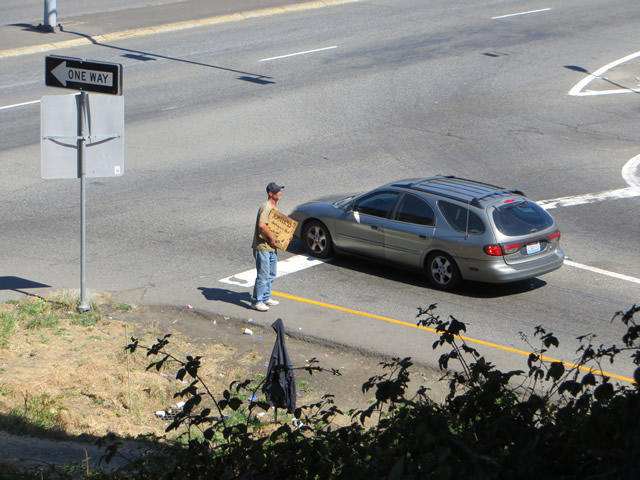
The guy is a distraction to traffic and a safety hazard. When traffic backs up around here, as it does during ball games, panhandlers will sometimes venture out into the street, darting in and out among the slowly moving traffic. Traffic jams are a prime time to panhandle, because drivers are a captive audience then.
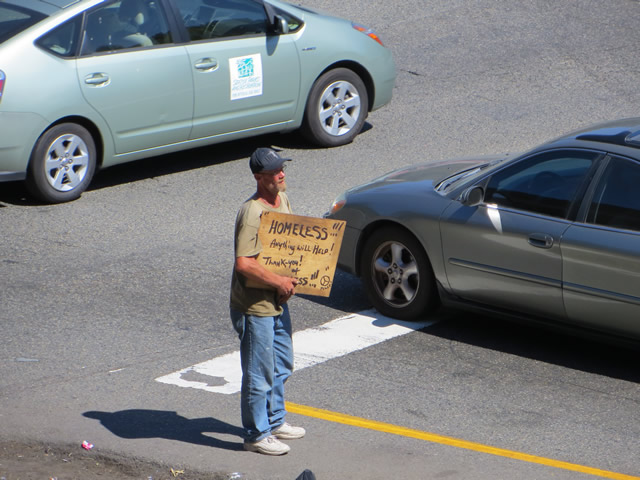
Seattle DOT has posted signs clearly warning people away from the area, but squatters and panhandlers pay these signs no heed, and the law is generally not enforced, unless the authorities are doing a “sweep” of the area.


Here are some shots of trash build-up in the area. Sometimes it’s hard to tell the difference between trash and people’s belongings. A bag or shopping cart full of detritus might be junk that needs to be thrown out . . . or it might be someone’s worldly goods. Either way, crap tends to attract more crap, and eventually you will see people dumping large loads of trash here.


In fairness, I must point out that there are other sites like this around the Seattle area. It’s not strictly a homeless camp-related phenomenon. These makeshift squats tend to occur all along the I-5 corridor, especially where there is cover for them. What I have observed about the homeless camp sites is that:
- There are more street squatters and panhandlers there. And they are more visible.
- There is more trash accumulation around these sites.
- The neighborhood itself takes on a different character, becoming a homeless zone.
I observed this with the Nickelsville camp that was in my own neighborhood of Highland Park for nearly three years starting in early 2011. There had always been a few panhandlers around there, as well as people living in the greenbelts around the camp area. But when the camp arrived, and for several months after it left, the number of street people in the area spiked upward. As I learned later, many of these newcomers were camp cast-offs, people who had once lived in the camp but were ejected for rule violations of one kind or another.
Postscript

This ^ is Scott Morrow, the man who runs Nickelsville Dearborn and its sister locations throughout Seattle and King County. Morrow is not homeless himself. Far from it. He runs two non-profit organizations that between them taken in hundreds of thousands of dollars in taxpayer money each year. He founded (and still effectively controls) another non-profit that receives tens of millions in taxpayer money. Beyond this direct influence, Morrow and his confederates have powerful connections in Seattle, King County, and Washington state government. Morrow has a paternalistic relationship with the people living in his camps and shelters. When the campers at the Dearborn location voted him out of the camp in late January of 2015, for example, he threatened the whole camp with eviction, whereupon he was immediately returned to power and the rebellious campers removed. (Story here.)
When I asked Morrow to discuss these events with me, he declined. Recently, the City of Seattle signed a contract with Morrow and one of his local non-profit allies to run three homeless camps in Seattle. Previously the camps had been sanctioned but not formally supported by the City. This new agreement changes that. Morrow and his confederates will now be paid taxpayer money to run these camps.
I am trying to get details on that, and to work with the City staff to make a sure a higher standard of accountability is applied to these camps going forward. At a minimum, there needs to be a robust appeals process for campers who have been evicted or otherwise disciplined. The City needs needs to exercise more meaningful oversight of the camps than it has hitherto, and needs to do some meaningful analysis on what, if anything, these camps do to move people out of homelessness.
–David Preston
Posted in General, Homelessness
Tagged chronic, crime, Dearborn, homeless, LIHI, litter, Low Income Housing Institute, Nickelsville, poverty, Scott Morrow, street drunks, traffic safety
5 Comments
Getting High With A Little Help From His Friends: The Scott Morrow Story
If you’re a regular reader of this blog, the name Scott Morrow will be a familiar one. If you’re not a reader, Morrow is the Seattle man who founded and controls two Seattle-area homeless shelter organizations. His Rotund Eminence can regularly be glimpsed at city council hearings and public demonstrations, looking like a cross between a hippie and an overgrown garden gnome.
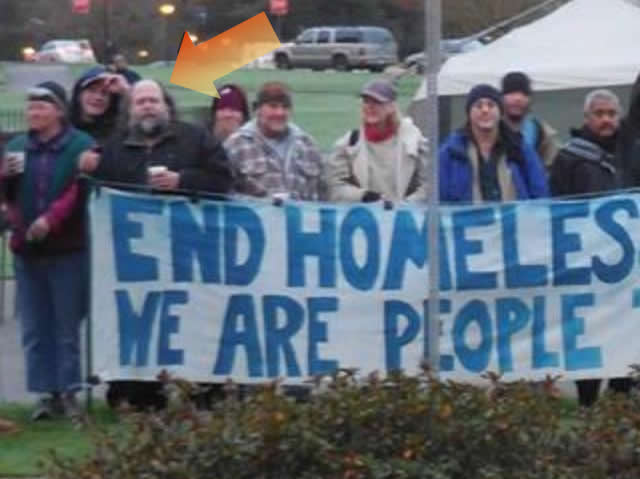
Mr. Morrow goes to Washington: Lobbying the state legislators in Olympia for more money “for homeless people”
Recently Morrow was in the news again. And not in a good way, as usual. Seems he’s been involved in another power struggle at one of his Nickelsville homeless encampments in downtown Seattle and the residents gave him his walking papers with a “no confidence” vote. At first, Morrow appeared to be going gracefully. The next day, he sent this e-mail around to the people at camp:
Scott-Morrow-Resignation-Letter-1.31.15
However, on Friday, February 6, the Seattle Times published an article describing how two key Morrow allies—the church that controls the land Nickelsville is on and a huge non-profit housing group called LIHI–threatened to pull the plug on the camp if Morrow wasn’t reinstated as boss.
From the Times article:
“It saddens us to inform you of the serious consequences of your recent vote of no confidence in staff person Scott Morrow,” the Lutheran Church of the Good Shepherd’s Rev. Steven Olsen wrote in an email.
“Scott’s role as staff person for the camp and liaison for the church host is an essential component of our working relationship. For this reason, your decision makes it impossible for us to continue as church host for Nickelsville,” Olsen added.
Olsen’s church controls the site under an agreement with property owner Coho Real Estate. The church has served as Nickelsville’s official host because a city law passed in 2011 allows religious entities to host tent cities with no permit and no time limit.
The Low Income Housing Institute, a financial backer of Nickelsville, also is abandoning the encampment, said the organization’s executive director, Sharon Lee.
“We have no confidence in the residents right now,” Lee said. “They’re not following the rules of self-management and they also voted out Scott Morrow.”
The Nickelsville residents who had booted Morrow were about to get back to the cold, rainy streets of Seattle if they didn’t tow Morrow’s line. Not surprisingly, the campers caved in. Three days later, on February 9, the Seattle Weekly ran a piece on the rebels’ capitulation . . .
In an email sent to local media today, Scott Morrow – the long-time homeless organizer and advocate who was ousted as the leader of Nickelsville on Jan. 29 – announced that he was reinstated by popular vote over the weekend. It’s an important development, and one that signals the end of a coup that threatened the camp’s future.
As we reported Friday, Seattle’s Low Income Housing Institute (LIHI), which pays for water, honey buckets and other services at the encampment, and Lutheran Church of the Good Shepherd, the church responsible for the agreement that allows the encampment to stay at its Dearborn Street location, had both threatened to pull their support if Morrow was not reinstated. Though Good Shepherd Pastor Steve Olsen told Seattle Weekly late last week that he remained “hopeful and prayerful” that a last-minute resolution could be reached, as of Friday LIHI and Good Shepherd were both preparing to cut ties with the camp. Without the support of LIHI and Good Shepherd, the 35 campers currently hunkered down at Nickelsville on Dearborn street would have faced eviction.
* * * * *
There are several worrisome things about this series of events.
► Blackmailing the Homeless
From Mr. Morrow’s resignation letter, it’s clear that he holds too much power over the people under his care. What he’s telling them, in essence, is that if they don’t let him be boss, he’s going to take his ball and go home. Or, in lieu of that, they can always BUY his ball from him by paying off the debts of the 501(c)3 organization that Morrow controls. In the Times piece, he claims that the Nickelsville 501(c)3 owes creditors $15,000. Presumably this is the amount the campers would have to cough up by Mr. Morrow’s February 5th deadline, if they wanted to stay on. Does it seem like a reasonable expectation that some three dozen homeless people would be able to scrape together fifteen thousand dollars in five days? Or does it seem more like blackmail?
Failing a payoff, the Nickelsville residents can always find themselves another non-profit organization to pay off the debt they owe to Morrow’s group. (Lots of luck with that.)
► Friends in High Places
Mr. Morrow’s leverage over the residents of Nickelsville goes well beyond his claim that the residents owe him money. As we see from the Times story, the residents would not have been allowed to stay, even if they had handed him $15,000 on the spot. There still would have been Ms. Lee of the Low Income Housing Institute to contend with. And also Reverend Olsen, whose church “controls” the land Nickelsville sits on. Olsen and Lee separately told the news media that, regardless of whatever other arrangements the homeless people at Nickelsville make, unless they reinstated Mr. Morrow as their boss, they would lose the patronage have to clear out, because they would no longer have the patronage of LIHI or the church.
As a result of my earlier research and tips from readers, I discovered a long-standing relationship between Mr. Morrow and Ms. Lee. Lee owes her six-figure-salary job to Morrow, since he’s a co-founder of the the organization she works for: the Low Income Housing Institute. See this story for an explanation of Mr. Morrow’s role.
Ms. Lee’s group controls tens of millions of dollars in government-subsidized housing properties in the Seattle area. The other two LIHI co-founders are Michael Reichert, director of Catholic Community Services (another non-profit whale), and Frank Chopp, Speaker of the House in the Washington State Legislature and an employee of Solid Ground (also a whale). All three of these heavy hitters Lee, Reichert, and Chopp are personal friends of Mr. Morrow’s. Chopp is particularly powerful. Between his job in the Legislature and his job at Solid Ground, Chopp controls the flow of hundreds of millions of dollars in housing projects in Seattle.
These whales all have their connections at City Hall. So, when a rag-tag band of rebels up and decides to toss Mr. Morrow out of the camp, what are the odds of Morrow’s friends at City Hall intervening on their behalf. And what are the odds of them pulling back the curtain to see just how Mr. Morrow runs his business, do you think? In addition to their multi-million-dollar contracts with Morrow’s friends at LIHI and Solid Ground, the City of Seattle also has contracts with Morrow’s other non-profit, SHARE (Seattle Housing and Resource Effort). Staff at City Hall and in the City’s Human Services Department tell me that the City likes Morrow’s outfit because it keeps people off the street and provides homeless shelter beds to the City at rock-bottom rates. That is . . . when Morrow’s not putting people out on the street himself . . .
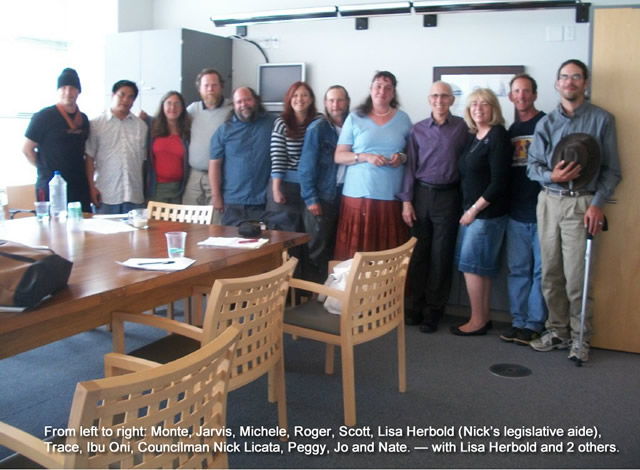
More friends in high places: Scott Morrow and SHARE with Councilmember Nick Licata, a long-time patron
► The Myth of Self-management
According to the residents of Nickelsville, as quoted in the Times story, all they wanted was the right to manage their community as they saw fit, without being threatened:
Anthony Jenkins and Lisa Hooper, two current Nickelsville residents, said they voted against Morrow because he had been threatening to take away resources, such as portable toilets, over a disagreement. Remaining residents are in talks with a different church and are hoping for an opportunity to operate Nickelsville themselves, Jenkins said.
“We just want a chance,” said Hooper, sitting inside the encampment’s tent kitchen Friday. “We can do this effectively.”
Over the years, Mr. Morrow’s representatives have assured the neighborhoods and churches that host his encampments that Nickelsville is democratically run and self-managed. Morrow has given the same assurances to government officials, in his effort to get City funding for his organization, SHARE. Indeed we see the same lingo popping up here again, in the words of LIHI’s Sharon Lee, as she explained why she was pulling LIHI’s backing from the group:
“We have no confidence in the [renegade] residents right now,” Lee said. “They’re not following the rules of self-management and they also voted out Scott Morrow.”
But wait . . . isn’t “self-management” exactly what the Nickelsville renegades ARE demonstrating? They’re thinking (and voting) for themselves for a change. And their democratic self-managed judgment was to remove Mr. Morrow–who is not homeless and is not a resident of the camp himself—from his position of authority over them. Mr. Morrow acknowledged this in the opening lines of his own e-mail:
At Nickelsville’s Weekly Meeting Thursday it was Moved / Seconded / and Passed that those gathered had ‘No Confidence’ in me as their staff person.
Apparently Ms. Lee has a very odd idea of what constitutes self-management. Over the years, numerous complaints have been made against Morrow–both formally, to civil rights organizations and city officials, and informally to the media, including this correspondent–to the effect that Morrow runs his encampments with an iron fist, expelling people who don’t support his political causes or show up at City Hall on cue to ask for more money for Morrow’s organizations. Even without this latest little saga as evidence, anyone with any background in the workings of Nickelsville knows the “self-management” sham for what it is.
► Church-assisted evictions
The Seattle Times story references a 2011 Seattle law that allows “religious entities to host tent cities with no permit and no time limit.” The city’s law in turn conforms with a 2009 Washington Supreme Court decision mandating that cities could not impose “undue burdens” on faith-based organizations who were exercising their religious beliefs by hosting homeless camps. The court decision means that Washington cities cannot bar churches from hosting homeless camps outright, nor can they impose permitting requirements so onerous as to have the same effect as a ban. Cities can, if they desire, go a step further and exempt churches from specific provisions of the permitting laws that would apply to all other citizens. Or at least they can until someone tests the matter in court. In any case, the City of Seattle does give such exemptions, and Mr. Morrow and his partner churches take full advantage.
Although Reverend Olsen and his flock at Church of the Good Shepherd are “hosting” Nickelsville, it’s not clear how this is an exercise of anyone’s religious faith. The camp is not on church property and the Times article does not discuss any work that Reverend Olsen and Good Shepherd are otherwise doing to support the people living at Nickelsville. The portable toilets and other services are being paid for by someone else, perhaps LIHI or Mr. Morrow’s organization. The land that the camp sits on, though it is “controlled” by Good Shepherd (whatever that means), is owned by a private real estate company.
Indeed, from the Times article, it would appear that Good Shepherd’s only role with regard to Nickelsville is that of an enforcer for Mr. Morrow. When the residents voted Morrow out, Reverend Olsen immediately stepped in and informed them that if they didn’t bow to Morrow’s will, they’d be evicted.*
Does Reverend Olsen see throwing people out of a homeless camp as an expression of his Christian faith? Surely this kind of behavior is not what the founders intended by “free expression of religion.” Therefore, the City of Seattle’s exemption for “religious entities” should not apply.
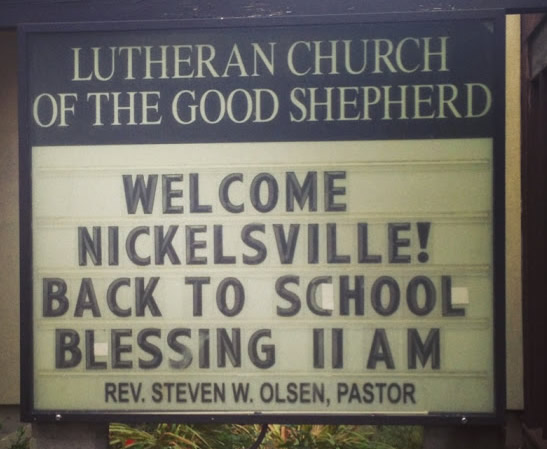
Church assisted eviction: God must have a sense of irony
* * * * *
I will be pursuing this story further, seeking comment from Reverend Olsen and Seattle officials. I’m not a fan of homeless camps, self-managed or otherwise. But if they are to be tolerated under city law, then they must not be allowed to become tools by which the wealthy and powerful–the Sharon Lees, Scott Morrows, and Reverend Olsens of the world–can hold poor people down.
==============================================
*Morrow using a church as enforcer is not something new; it’s part of a pattern. In this story from February of 2014, there was a confrontation at another one of the Nickelsville homeless franchises in Seattle. In that case, too, the residents decided they didn’t like Mr. Morrow telling them what to do, so they ousted him, and the host church threatened to pull the plug on then a day or two later. In that case, the camp disbanded and several dozen homeless people were returned to the street.
Posted in General, Homelessness, Nickelsville, Politics
Tagged 1st Amendment, frank chopp, homelessness, LIHI, Low Income Housing Institute, Lutheran Church of the Good Shepherd, Michael Reichert, Nick Licata, Nickelsville, religious freedom, Reverend Scott Olsen, Scott Morrow, Seattle Housing and Resource Effort, SHARE, Sharon Lee
14 Comments
Duwamish River Dredging
The Environmental Protection Agency (EPA) sent out a letter to my neighborhood in November 2014 (see below.) The letter notifies people living around the Duwamish River about EPA-sponsored clean-up work on the river.
According to a City of Seattle Web page, the Duwamish River was listed as an EPA Superfund site back in 2001. However, it wasn’t until a few years ago that federal and local authorities could scrape together the money to actually get started with the clean-up. Now that the money’s in the bank, the clean-up is well underway.
Here’s what the dredging part of the operation looks like:
Click on either of the page images below to enlarge the letter for reading.
Weed Wars: Medical vs. Retail Pot in Seattle

Here’s an at-a-glance look at medical marijuana (MMJ) dispensaries in one neighborhood of Seattle. All these pictures were taken in a four-block radius around the main drag of White Center, a poor and working-class suburb to the immediate south of Seattle. (See Google map below.) Traditionally associated with crime and squalor in the mind of her higher-brow neighbors, White Center saw a brief renaissance in early 2000s, but that has since died down, and squalor seems to be getting the upper hand once again. Sitting at a booth in one of the hipster eateries and boutiques of a dreary afternoon, one can see a procession of junkies, winos, and small-time hustlers shuffling by on the pavement outside.
For more analysis, read the text that follows the photos. Continue reading
The Ecology of Failure
So one of my hot tippers calls me today and tells me I gotta get down to the bottom of Highland Park Hill, where the state DOT is cutting brush and clearing out some homeless people. So I rush down there with my cam-cam and discover that, sure enough, they’re doing a hatchet job on a green belt. I’ve seen these operations before, but never one this extensive. They had chainsaws, brush cutters, and a big-ass chipper. You can see in the pix below that they’ve cut down at least one big tree – a 10-inch paper-bark birch – and that they’ve pretty much cleared the ground near the road of all vegetation. As a result of this operation, the soil will begin eroding immediately. It’s ironic that the State spent a lot of money planting this area some 20 years ago just to make it look nice and to provide habitat for animals. Now that’s all being undone.

Brush being cut near former site of Nickelsville homeless encampment.
So why is this happening? Is it the economy? Is it those bad old 1%ers? Oh hell no! This is happening because of a series of ongoing mistakes by Seattle and King County public officials.
Three years ago, a homeless camp calling itself Nickelsville moved onto public land just two blocks away from this site. (The camp was named for Seattle’s then-mayor Greg Nickels, whom the camp operators despised for daring to resist them.) Although Nickelsville purported to be a democratically run self-sustaining “eco-village” it was in fact an unsanitary eyesore that was run by a single man and his girlfriend, neither of whom were poor and neither of whom lived at the camp. The camp bosses at Nickelsville regularly exiled individuals from the camp for infractions great and small. Unfortunately, when people were evicted, they didn’t go far. Often they simply walked across the road and set up shop in the nearest green space, as you see right here. When Nickelsville was finally evicted by the City last year, dozens of hard-core “Nickelodeons” fled into the woods, refusing all offers of housing assistance from the City.
Not surprisingly, drug use has been rampant in the woods around the old Nickelsville site. Sanitary conditions are even worse than they were at Nickelsville, and that’s saying something.
Periodically, City authorities will sweep through with a “bag and tag” operation. In a bag-and-tag, the cops give everyone written notice to vacate (see photo). Then they bag up all the shit that’s left after moving day and throw it away after 2 weeks if it’s not claimed. Before a sweep, the City will send out social service workers to contact everyone who’s living in the area directly and tell them they’re gonna have to leave. The city workers will offer support services to the squatters (motel stay vouchers, referrals to shelters, medical info) but the squatters are free to decline. And they usually do decline. Or at least, that’s what city officials tell me.

A trailer that’s been used as a temporary domicile for one or more people sits on the roadside nearby.
Depending on the site, work crews may then come in and cut trees and brush, to deny squatters the ground cover they like to hide in. You can see from the pictures what effect this is having on the ecology . . . but when I say “failure” I’m not really talking about homeless people. I’m talking about government. Specifically, I’m talking about a government that has been unwilling or unable to stand up to the people who run Nickelsville and to the politicians who help them. And I’m also talking about citizens, citizens who have let themselves be bullied or guilt-tripped into thinking that there is no other choice but to put up with drifters and drug addicts squatting on public land.

Notice to Vacate signs posted by Seattle City workers let homeless people know that will have to leave by a certain date.
Fortunately, things are beginning to change. I’m fighting, along with a small but growing number of concerned people, to put a stop to this practice of naive tolerance. Hanging out in the woods is not a valid lifestyle. Homeless people need to accept City services when they’re offered or leave. And so-called homeless advocates need to stop pushing the City and County to allow (read: encourage) more encampments and squatting on public land. That is a dead end, any way you look at it.
Posted in General, Homelessness
Tagged bag and tag, homelessness, long-term homelessness, Nickelsville, Nickelsville Highland Park, squatters, sweep, tent cities
1 Comment
Homeless Camps: My Testimony to the King County Council (Part 2)
Mary Bourguignon
Principal Legislative Analyst
Lead, Government Accountability & Oversight Committee
October 23, 2014
Dear Mary:
Here’s another set of comments and information for the Council to review.
Note: SHARE is an acronym for the Seattle Housing and Resource Effort, a local non-profit housing group that has extensive dealings with King County government and with the King County Council in particular. SOCR is an abbreviation for the Seattle Office of Civil Rights.
Attachment 1: Extract from a Seattle Office of Civil Rights complaint against SHARE (Case #SOCR10HO067)
This case is a complaint filed with the SOCR by Ms. Dominique Trudel. In the complaint, Ms. Trudel says that in late 2010, she had been staying in a SHARE-run shelter in Seattle when a male shelter resident, Dale Jackson, began sending her sexually inappropriate text messages. She complained to shelter staff about this and was ignored. When she later checked Jackson’s name against a police sex-offender list, she discovered that Jackson was a convicted rapist. At that point she contacted Seattle police on a non-emergency number and asked them to talk to Mr. Jackson. Unfortunately, when a Seattle police officer tried to contact Jackson, he had already disappeared, never to return.
When SHARE staffers discovered that Ms. Trudel had contacted the police on her own, without asking their permission, they evicted her from the shelter immediately, putting her back out on the street with Mr. Jackson. If you look at complete file at the Seattle Office of Civil Rights, you’ll see testimony from Ms. Trudel describing her state of mind after she was evicted from the shelter. She was very frightened and distraught. It was night-time, she was on the streets, and she felt that she was being followed by someone.
Significance of Ms. Trudel’s Civil Rights Complaint against SHARE
What does this document say about the Seattle Housing and Resource Effort (SHARE)? What does it say about a county government that would do business with such an organization?
SHARE already receives hundreds of thousands of dollars in cash and in-kind donations from King County taxpayers each year. SHARE will be the primary beneficiary of the proposed encampment ordinance extension as well. Not surprisingly, SHARE has had significant impact on the creation of this legislation, through their regular appearances at County Council meetings and through their representation on advisory governmental advisory boards such as the Committee to End Homelessness in King County, where they have two slots reserved for them. (Anitra Freeman and Jarvis Capucion are both SHARE staffers.) SHARE has also had representation on various Seattle City taskforces dealing with homelessness.
Ms. Trudel’s complaint is evidence that SHARE is not able to maintain security at their shelters. Beyond that, it suggests that people in SHARE shelters who contact the police on their own are punished for doing so. When you take Ms. Trudel’s experience together with the Bellevue Police report on a drug overdose death at Tent City 4 (see attached) and various reports in the newspapers over the years, you get a picture of an organization that not only disregards the safety of the homeless people under its care but actually interferes with the police who are trying to protect them.
Note: After the initial complaint was filed and statements were taken, SOCR was unable to locate Ms. Trudel to determine if she wanted to follow through. However, SHARE does not contest Ms. Trudel’s most important claims of fact. For example, SHARE does not contest Ms. Trudel’s claim that she had gone to SHARE staff with complaints against Dale Jackson before she called the police. And SHARE does not contest Ms. Trudel’s claim that she was evicted as a direct result of her contacting police. SHARE’s representatives maintained throughout that they considered Ms. Trudel’s call to the police a “frivolous” and that it was a violation of SHARE’s rules on emergency calls.
Attachment 2: SOCR Inquiry Response from Marvin Futrell
This document was sent to SOCR in late 2010 by Mr. Marvin Futrell, “SHARE Mens Organizer.” Mr. Futrell’s letter is in response to a a query from SOCR regarding Ms. Trudel’s complaint. In the letter, Futrell states SHARE’s official position on the matter, which is that Ms. Trudel made a “frivolous 911 call” without getting approval for it first. Mr. Futrell’s conclusion was that Ms. Trudel deserved to be evicted from SHARE housing:

Significance of Marvin Futrell’s letter
Marvin Futrell’s letter crystallizes SHARE’s problems with the police and security. Beyond that, the document could be important because I believe the Marvin Futrell who wrote it is the same “Marvin” who was in charge of Tent City 4 on July 1st of 2014, when a homeless man there died of a drug overdose. If you will recall from the Bellevue police report of that incident I sent you earlier (also see attached) the Marvin in charge at Tent City 4 not only refused to cooperate with the police investigation himself, he told others at the camp to not to cooperate as well:

Although the Marvin at Tent City 4 refused to give his last name to the police, his identity could easily be verified by checking with the police officer who filed the report. Whether it’s the same Marvin in both reports or not, it IS the same SHARE.
–It’s the same SHARE that’s always refusing to cooperate with police.
–It’s the same SHARE that’s telling others not to cooperate with the police.
–And it’s the same SHARE coming to the King County Council now, asking for another 10 years to operate their camps as enclaves of lawlessness and squalor, free from police interference.
I’ll repeat what I’ve said to the Council many times before . . . the proposed ordinance should not be approved until such time as the Council can be assured of SHARE’s cooperation in enforcing the law and in protecting the people in its camps and shelters.
Thank you.
Sincerely,
David Preston
Attachment 3: Bellevue Police Report From a July 1, 2014 Incident at Tent City 4 (For reference)
Homeless Camps: My Testimony to the King County Council (Part 1)
The testimony below concerns a proposed King County, Washington Ordinance extending (with proposed modifications) county legislation governing homeless encampments, also known as “tent cities.” I have been following the operations of these camps for several years now and, with one exception, the camps have all been operated by a single non-profit organization known as the Seattle Housing and Resource Effort (SHARE). The central problem with the proposed legislation is that it allows SHARE to continue to operate in a legal twilight zone in which it can do essentially anything it wants to without being accountable to its hosts, to the police, to county government, or to the taxpayers.
I’m presenting this testimony to the Council in several stages, in both oral testimony at Council meetings and via e-mail. Below is the first of several parts. (Note, click on the links to see the full documents.)
Mary Bourguignon
Principal Legislative Analyst
Lead, Government Accountability & Oversight Committee
October 17, 2014
Re: Proposed Homeless Encampments Ordinance (2014-0424)
Dear Mary:
Attached are three documents I want you to share with the King County Council. There will be more in the weeks to come.
Attachment 1: My Oral Testimony to the Committee of the Whole on Monday, October 13, 2014.
Unfortunately, I did not get a chance to read the last paragraph to the Council because my time ran out. As you may know, after I gave my testimony, Mr. Dembowski vigorously denied my accusation that he had not responded to my concerns, but I will send you evidence in support of my claim. That’s for a future batch of documents.
Attachment 2: Bellevue Police Report From a July 1, 2014 Incident at Tent City 4 (15727 NE 4th ST, Bellevue)
I have redacted the name and address of the person requesting the file. I have also highlighted the parts of the file that are relevant to the question of where the camp operators stand on the question of cooperating with police. The highlighted areas show that the man in charge of the Tent City 4 (TC4) camp on July 1st – a man who identified himself to police only as “Marvin” – refused to help police investigate a drug overdose death at the camp. At least two investigators noted Marvin’s obstructive demeanor, and they further suggest that Marvin encouraged other people at the camp not to cooperate with police officials or the medical examiner’s office. Here’s a sample excerpt from the report:

“Marvin” – the boss of Tent City 4 – refuses to cooperate with police investigating a drug overdose death.
It’s important to remember that TC4 – like nearly all large homeless encampments in King County – is run by the Seattle Housing and Resource Effort (SHARE). It’s also important to understand that the “Marvin” in question here is almost certainly one Marvin Futrell, who has been employed by SHARE for several years as the on-site boss of one or another of SHARE’s operations. You’ll be hearing more about Mr. Futrell in a subsequent e-mail.
Significance of the Bellevue Police Report
The police report is important for two reasons. First, it shows that, notwithstanding the many glowing accounts of the secure, drug-free conditions at homeless camps that the Council has heard from SHARE supporters, drugs are getting into the camps and camp security is poor. Be aware that Mr. Wosser’s death is not the first drug overdose death that has occurred at a SHARE camp, nor is it likely to be the last. Second, the report shows that, far from helping officials to protect people at Tent City 4, SHARE staff actively obstructed those officials from doing their job. Local news stories from around King County have documented that SHARE refuses to give information on who is staying at their camps to government officials, even when that refusal puts camp residents and the public at risk.
Attachment 3: Summary List of 9-1-1 Responses To Nickelsville (May, 2011 through April, 2013)
I compiled this summary from three MS Excel spreadsheets the Seattle Police Department sent me in response to a public disclosure request. The list shows 104 police incident responses that happened at or near the (former) Highland Park location of Nickelsville. Nickelsville is a series of homeless encampments run by SHARE. In contrast to tent cities, Nickelsvilles are often unpermitted (that is, illegal) and they typically allow things that are not permitted under encampment legislation or local codes. For example, the Nickelsville encampment stayed in Highland Park for over two years illegally and didn’t leave until it was forcibly evicted by the City of Seattle in late 2013. Nickelsvilles in Highland Park and downtown Seattle have also allow children to stay there. (During Nickelsville’s stay in Highland Park, several children were removed by CPS and put into foster homes.)

A report of SPD 9-1-1 responses at Nickelsville shows that homeless camps are not the tranquil places their supporters claim.
(Note: Even though Nickelsvilles are not always under the County’s jurisdiction, Nickelsville should always be on the County’s radar, and there are several reasons for that, the most important of which is that Nickelsville is run by SHARE, the same organization that operates tent cities. Another reason the County should care about Nickelsville – even when it’s not on County-controlled land – is that it usually ends up costing the County time and money anyway, as it did when the Health Department was forced to spend tens of thousands of dollars to ameliorate a rat infestation at the Highland Park location in late 2012.)
Significance of the Seattle Police Department Nickelsville summary report.
Just as the Bellevue Police report on the drug overdose death at Tent City 4 belies SHARE’s claims about drugs and security there, the SPD summary report belies SHARE’s claims to Nickelsville’s neighbors in Highland Park. Yes, SHARE told Highland Park residents – including me – the same lies they tell every other community: There are no drugs at Nickelsville, they said. There is no crime there. We will cooperate with the police to keep the bad people out . . .But it was all just pretty words. The reality was much less glamorous.
As I explained to the Committee of the Whole last Monday, the organization that runs these homeless camps has not acted in a reasonable or accountable fashion. There is no possible justification for refusing to cooperate with a police investigation, just as there is no reason for the citizens to tolerate a condition where drug dealers and other criminals use these camps as a refuge. In the weeks ahead, the Council is going to be hearing more from me on this matter, both via e-mail and in person, at the meetings. I have detailed, documented accounts of crimes committed by people at these camps. And worse: I have documented evidence of County officials lying to the press and looking the other way while the camp operator disregarded the law, along with numerous ethical violations committed by the camp operator and its employees.
As I said in my statement, until such time as the County can be assured that these camps are helping people get out of homelessness and the camp operators can be held accountable to the citizens for their actions, the County should not sanction even one more homeless camp within its borders.
Sincerely,
David Preston
Democracy is . . .
. . . thinking for yourself
You know, I’ve always thought it odd that newspapers would try and tell Americans how to vote. And I’ve always thought it even odder that voters would actually do what the newspapers tell them to. Yet still, it happens. Are voters just lazy? Or are they stupid? No. Don’t answer that . . .
I want to laugh at some of my liberal friends here in Seattle, railing against big corporations influencing their vote, and then, the week before an election, they’ll go to the Seattle Times or The Stranger (“Seattle’s Only Socialist-Capitalist Newspaper”) looking for the sections that says: “Here’s how you should vote . . .” Ha ha ha!

Wanna be a unique individual in Seattle? Then read the Stranger. Just like everyone else.
Excuse me, my liberal friends, but were you under the impression that the Seattle Times wasn’t a corporation? And what about The Stranger? Did you think they don’t have to suck a little corporate pee-pee now and then? Yeah, it’s a “free” paper, but who did you think pays for it to be printed up by the thousands and dumped at every corner restaurant? The Parks Department maybe? No, sillies! It’s advertisers. Advertisers pay for The Stranger, And those advertisers influence the paper’s editorial position, too, naturally. For instance, there’s a whole ad section in The Stranger just for cannabis ads. Can you guess where the Stranger stood on legal marijuana? (They only ran like a dozen front-page stories endorsing it.) There’s also a page full of ads for hookers at the back. So . . . wild guess . . . where do you think The Stranger might stand on legalized prostitution?
Read The Stranger’s “Marijuana Guide” HERE.

Stranger staffers regularly take hiatuses to support liberal political campaigns. Sometimes politicians will even hire these staffers after they get into office. I guess that’s their way of saying of “Hey, thanks for the support.”
The Stranger makes no bones about what they’re doing. Elections are complicated, after all. Much too complicated for them to be able to give you the whole story in a two-page spread. But why waste all that time reading up anyway, when The Stranger’s already done all the reading – and thinking – for you? Just sit back, take a bong hit, vote the way they say, and everything will be allllll right.
Ssssssssssss!!!! [Cough cough cough] Hey! I think I feel a buzz coming on.
The Seattle Times does exactly the same thing as The Stranger, of course, and people should be leery of the Times‘ campaign endorsements for exactly the same reasons. Unlike television, print media still has a certain gravitas attached to it; when people see something in writing from an established newspaper, they tend to give it more credibility. They should not do that, though.
Newspapers should never endorse candidates or issues. If they want to host debates and do stories and analysis, that’s fine, but beyond that they should never venture. Moreover, alongside their analysis, they should always be candid about how any particular campaign could affect the newspaper’s shareholders, private owners, or advertisers.
Example: Several years ago, the Times came out strongly against a proposed state income tax on people with an income over $250,000, saying it would be bad for the state. OK, maybe the tax would’ve been bad for the state, maybe it wouldn’t. But this much we know . . . it would’ve been bad for the owners of the Times personally, as well as owners of many local businesses that advertised in the Times. So the Times should’ve come out and admitted that up-front in a big bold disclosure statement. Then voters could decide for themselves whether Times coverage of the initiative was “fair and balanced.”
Read the Seattle Times’ warning against a state income tax HERE. (Never mind that it’ll affect them personally. I’m sure that didn’t affect their judgment.)

Posted in Essays, Media, Politics
Tagged campaign endorsements, marijuana, money in politics, prostitution, Seattle, seattle times, Stranger, unpaid advertising
Leave a comment
Drug Buy at 3rd and Pike in Seattle (10/18/14)
Heroin
–Great for Tourism
–Great for the Locals
–Everybody Wins!
Heroin’s already cheap as dirt in Seattle. Now all they’ve gotta do is make it legal, just like marijuana.
Well, City Council? We’re waiting!
Posted in Photos (Stuff)
Tagged 3rd and Pike, Curt Kobain, drug trade, heroin, Seattle, Walgreens
1 Comment
Robin Hood, Inc.
This story should not come as a surprise to anyone, since Seattle has the highest percentage of hero-hypocrites in the nation, per capita. It’s almost too easy to be a hero here. All you have to do is kvetch about how other people should be forced to spend THEIR money to fix social problems.
But when it comes to spending YOUR OWN money?
Oh. Hell. No.
Seattle Socialist Party Pushes $15 Min. Wage, Stiffs Workers
This story was sent to my by TBQ user Livin Large. Thanks, Large.
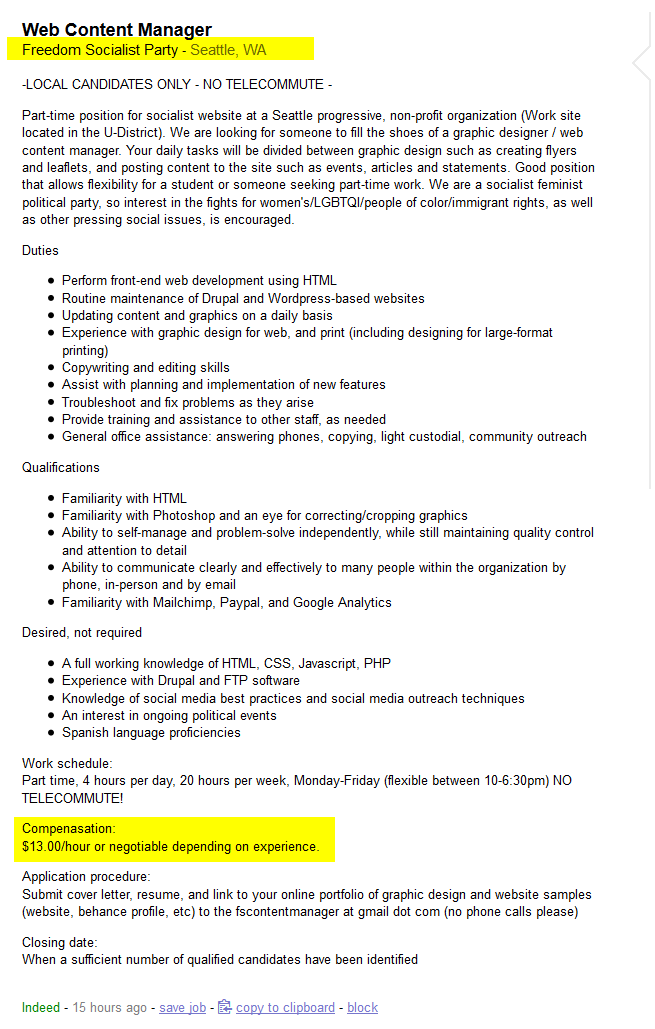
Job Offer from Freedom Socialist Party
Posted in Politics
Tagged 15 now, Freedom Socialist Party, hypocrisy, Kshama Sawant, minimum wage
Leave a comment
Take Our Tunnel . . . PLEASE!

“The world’s biggest tunnel-boring machine, nicknamed Bertha — which hit a pipe and was damaged in mid-December after only 1,000 feet of excavation — is down there in the dark, awaiting what may well be the world’s biggest industrial rescue operation.”
–New York Times article from August 14, 2014.
–Oh fuck! Can you believe it? They were digging a billion-dollar tunnel and . . . wonder of wonders . . . the tunnel machine bit into a PIPE and choked. Now who would’ve expected to find something like that buried down there. Of all the crazy things! A pipe!
Posted in General, Politics
Tagged boondoggle, infrastructure, tunnel, Washington State Department of Transportation, WSDOT
Leave a comment
Seattle: The Entitlement City™
Below is a copy of an e-mail cc’d to me by a friend. It’s a complaint he’s making to Sound Transit, the commuter bus service that runs between Seattle and several of the surrounding cities . . . I’ve included a file photo of the type of dog my friend is complaining about, a blood hound. As you can see, they’re large dogs.
Via e-mail to main@soundtransit.org on 10/14/2014
Re: Sound Transit Dog Policy Enforcement
Dear Sound Transit,
I’m writing to appeal for your cooperation in instituting tighter controls by your coach operators to enforce your dog policy and enhance the structure around what is defined by a “Service Animal.” On your online published basic rules for bus and train passengers is this first item – “Animals: Service animals are allowed on Sound Transit buses and trains. Pets may ride if they are carried in small containers.”
Yesterday I witnessed this spectacle on boarding the #512 bus southbound for Seattle at the Ash Way Park & Ride around 3:30pm: A full-grown bloodhound (!) on the driver side of the bus in the senior citizen area. The owner had spread her belongings on the seats on both sides of herself taking up 4 spots (!) and her animal sniffed each boarding rider with its snot-dripping nose. She fussed with the dog’s ears, removing material she then would drop on the bus floor. On the opposite side of the bus, a man held a small dog on his lap. Then once underway, he let the dog walk on the bus seat (!). She asked the other animal owner if he cleans his dog’s ears? He said no. She exclaimed loudly, “Well these dogs are known to have a lot of crud in their ears-it’s a full-time job!”

File photo: Large bloodhound
I was FURIOUS! Neither animal had any service animal identification or bibs visible, and neither animal was in any container, let alone “small.” The Ukrainian operator had allowed both of these animals aboard. This has been increasingly happening on the bus with your policy being flaunted more and more often, and I’m sickened by it. If you saw a human wanting to board who licked his privates in public, you definitely wouldn’t allow that human to board the bus (and you’d probably call Security to boot). The dog owners set a gauntlet we have to pass by as their dogs run their wet noses over our passing pant legs. And whether the rider favors dogs or not, this is a public health issue. But most importantly, it makes me daydream about not wanting to ride the bus anymore. I drive a couple of days a week, but could very easily switch to driving every day. It won’t take much.
I would also like to bring to your attention the real cottage business of Service Dog bib fraud. A friend of mine south of Missoula, Montana described a lady there who routinely sews and sells fake Service animal bibs to dog owners who don’t want to be constrained by societal rules for keeping their dog out of places they shouldn’t be.
I suggest instituting a Sound Transit Service Animal pass that owners have to obtain from the Ridestore with staff there verifying documents showing their animal is an authentic Service Animal. Then the owner needs to be required to run the pass by the Orca [boarding card] reader each time they want to board the pass with their Service Animal to verify they are in your database. I know Orca is a fare tracking program, but since you mention that Service Animals ride free, you could program those passes as free. All others without this ID should not be permitted on the bus, PERIOD, unless, as your policy states: they are small and contained in a closed carrier.
Please enforce this out of respect for those of us who would not think of imposing our pets on fellow riders. With your planned fare increase, please consider this additional reason those of who have the choice would consider not riding the bus anymore.
I welcome your response.
Sincerely,
Mark B_____
(12-year Sound Transit passenger, but considering quitting)
Death in a Homeless Camp
Originally published on October 14, 2014
Background:
Tent City 4 is a large homeless encampment managed by a group known as the Seattle Housing And Resource Effort (SHARE). SHARE is a registered 501(c)3 charity that solicits funds from government and private sources. SHARE has an annual budget of several hundred thousand dollars, much of which is not properly accounted for on SHARE’s annual 990 income tax form. SHARE does not make their budget public.
SHARE operates both permitted and unpermitted (illegal) homeless camps in and around Seattle. In order get a permit for one of its legal encampments, SHARE is required to hold community meetings in advance and is required to address neighbor concerns about drug use in camp, community safety, sanitation, and so on. At these meetings SHARE representatives (including some camp residents) stand up and assure the community that the camps are being run safely, that no drugs are allowed on the premises, and so on. However, police reports tell quite a different story.
A colleague of mine recently filed a public disclosure request with the Bellevue Washington Police Department in response to a drug overdose death that occurred in early July, 2014. This death is not the first drug overdose at a SHARE-run camp. It is certainly not the first drug-related incident or arrest that’s happened at a camp.
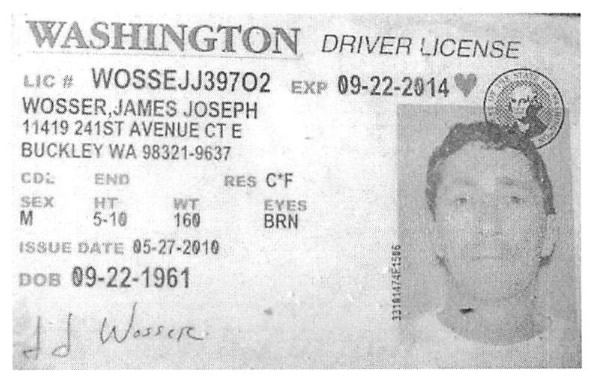
This police report is noteworthy in two respects: First it suggests that SHARE either can’t or won’t police drug activity in the camps that it runs. Second, it suggests that, far from cooperating with the police and community in keeping out drug users, SHARE management (as represented by the “Marvin” in the police report) are willing to obstruct police investigations into drug use, even when that use leads to one of the camper’s deaths. As you read through this report, pay attention to the parts I’ve highlighted. You’ll see how Marvin tries to control the flow of information about what goes in the camp to the outside world. On page 9 we see that one of the Bellevue police officers, a Detective Mangione, observed drug paraphernalia in the victims tent, but when he tried to determine the victim’s identity and get the details of what had happened, the staff at Tent City 4 was “uncooperative.”
Please share this link with anyone you know in the Seattle or King County government. Tomorrow, the full King County Council will be reviewing a proposed ordinance on temporary homeless encampments (Proposed Ordinance No. 2014-0365). This ordinance is largely being written with SHARE in mind. The sponsor of the bill is Councilmember Rod Dembowski. His e-mail address is rod.dembowski@kingcounty.gov. His phone number is (206) 477-1001.
See the full police report on James Wosser’s death here: Death of James Wosser
Grannie Makes Bank Selling Warm Fuzzies
Now I’m not claiming that this lady is typical of panhandlers in terms of her life situation. In fact, most panhandlers I see in Seattle are scruffy, and they DON’T drive nice cars. Most are mentally ill and drug addicted and are either homeless or just barely off the street. In other words, they’re ’bout as different from Grannie here as they could be.
There’s something the scruffy guys do have in common with Grannie though, and that’s that they’re both perpetrating a fraud. They are both leading their kind-hearted but naive benefactors into thinking that she’ll be using the money to pull themselves out of a rut. In Grannie’s case, she won’t be doing that because she’s not IN a rut. But even if she were, it’s highly unlikely that she’d be getting out of it through panhandling. Of all the panhandlers I’ve known, not one has ever improved his or her long-term condition as a result of panhandling. To the extent that panhandling did anything at all for them, it kept them down.
Angry Irish Bum Tours
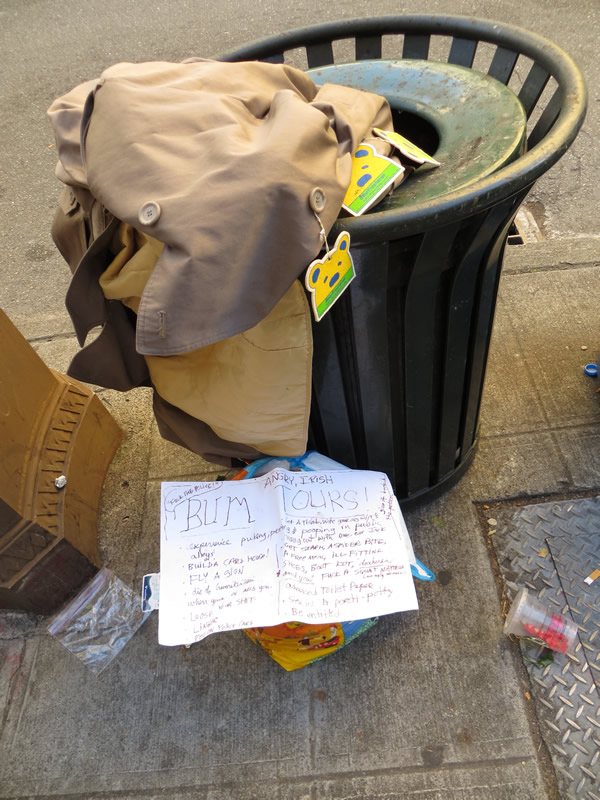
Angry Irish Bum Tours
Downtown Seattle
Saturday, September 6, 2014
This picturesque tableaux was discovered around 1st and Seneca, just a block from the Seattle Art Museum and Benaroya Hall, two world-class cultural amenities. It’s not uncommon to see crud like this around on the sidewalk at all hours and even during high tourist season. Apparently some angry and sarcastic homeless person has decided to ditch his duds, along with a collection of his writings. Actually, there’s a good chance that what happened here is that dude was tossed out of the Downtown Emergency Service Center (DESC) or some other free squat in the vicinity, and he didn’t have the wherewithal to take his shit with him. I’ve moved folks in and out of these places, and believe me when I tell you that it’s an education in how little a person actually needs to “own.” I’ve seen people throwing away family pictures, treasured heirlooms, everything but what they could carry with them and sleep on. After just a few weeks of being homeless, you know the drill: Whether you’re under a roof in a downtown squat or right out on the street, if you can’t keep a eyewatch on it 24/7 then lose it NOW, because your’e gonna lose it in the end anyway, and in the meantime it’s gonna cause you nothing but grief.
There was a wealth of good material in the bag, and I would’ve liked to take some of it with me as a souvenir. But I didn’t know where that material had been, and my companions were waiting, so I gingerly unfolded the first leaf, took the photo, and then moved on.
With spelling corrected, the paper reads:
“Fuck the Police”
Angry, Irish BUM TOURS
• Get a ticket, wipe your ass with it, give it back to the police
• Experience puking, peeing, and pooping in public alleys [Nice alliteration! -Ed.]
• Build a card house!*
• Fly a sign**
• Die of humiliation when your ex sees you
• Lose your shit
• Linger
• Pee on police cars
• Hang out with One-ear Jack
• Get staph, a spider bite, a free meal, ill-fitting shoes, boot rot, diarrhea and you***
• Fuck a squat mattress (an ugly woman)
• Advanced toilet paper
• Sex in a porti-potty
• Be entitled
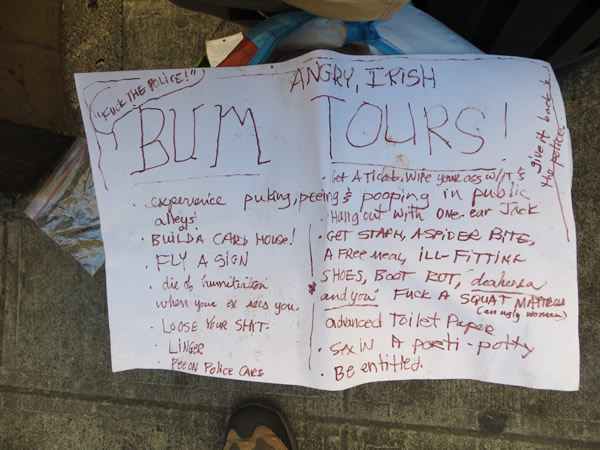
Close-up of Sign
Editor Notes:
* I don’t know what “building a card house” means. It might refer to gift cards, meal tickets, or something of that nature. Or perhaps fake IDs.
** Refers to holding a sign up to street or sidewalk traffic, asking for money. (Panhandling)
*** Play on an old Jimmy Rodgers tune (Miss the Mississippi and You)
Posted in Photos (Stuff)
Tagged Angry Bum, Bum Tours, DESC, Downtown Emergency Service Center, homeless
Leave a comment
Where to now, Robin Hood?
Here’s an interesting segment from today’s Dori Monson’s show on KVI radio in Seattle. In this bit, the host is talking about how Seattle’s class divisions are paradoxically widening as a result of the city’s Robin Hood-like efforts to help the poor. He’s comparing our city to San Francisco, which has undergone a similar evolution, only sooner. While much of what Monson says is clearly hyperbole, there’s enough truth in it to make you wonder: Seattle has been throwing money at the homeless problem for years now, but it seems like there are more homeless than ever. So perhaps we should be asking ourselves some questions.
What is the yardstick by which we measure our success or failure?
Where are the standards by which we judge whether we, as a city, are doing more or less than our fair share?
Listen to Monson’s Segment on Downtown Seattle by clicking HERE.
Photo below by David Preston, taken near his home in Highland Park.

P.S. I know this guy, and that’s why I’m not identifying him by name. He’s a good guy, but I know for a fact that he doesn’t want to work, even though he can.
Will a $15/hour minimum wage hurt Seattle business?
I recently asked the Seattle City Council to share with me any data they were looking at in their deliberations on the proposed minimum wage hike for Seattle. They sent me two studies, which I have linked for you below. The first study was prepared by the University of Washington specifically for the City Council:
University of Washington Minimum Wage Report
At 107 pages, it’s just a damn long report, and although it does contain a lot of info, it’s not well organized or explained. To help you along, I’ve highlighted some of the material that I consider most relevant.
The most important thing the UW report tells us is how many workers will be directly affected if the minimum wage is raised to $15 (102,000) and what businesses those people will be in (restaurants, retail, health care, warehouses).
The second study the Council used was prepared for them by three University of California-Berkeley wonks. It’s here:
UC Berkeley Minimum Wage Report
As with the UW report, I’ve highlighted some of the UCB report text you might want to pay special attention to.
The second report strongly suggests that a minimum wage hike in Seattle will not have a significant negative impact on business because similar wage hikes in San Francisco and San Jose did not have such an impact.
* * * * *
As the world knows by now, Seattle Mayor Ed Murray just announced his plan to raise the minimum wage to $15/hour. The raise will be staggered across different sized business and will be implemented in increments, with the last increment to be finished by 2021. See more on that story here:
Seattle Times: Mayor Murray’s Minimum Wage Plan Announced
In making his decision, the Mayor undoubtedly relied heavily on the UCB minimum wage impact report. That report argues – convincingly I think – that the San Francisco wage hike was good for workers without being bad for business.
Two grains of salt should be taken along with the UCB impact report. The first is that the report was prepared by people who almost certainly favor wage hikes. If you read the document closely, you’ll notice that the lead authors, Michael Reich and Dan Jacobs, cite their own research more often than they cite other studies. Collectively Reich and Jacobs have authored no fewer than seven research studies that they cite at various points in their impact paper. That’s what’s known as academic incest.
The second critique I would make of the UCB report is that the analogy it makes between Seattle and San Francisco may not be valid. San Francisco’s cost of living is considerably higher than Seattle’s (especially when rents are taken into consideration) yet San Francisco’s current minimum wage was just boosted to $10.55 per hour – much lower than the $15/hour wage that Seattle City Councilmember Kshama Sawant had originally proposed, and not much higher than Seattle’s current rate of $9.22/hour. That suggests that the cost of labor was already considerably more out-of-synch with the cost of living in San Francisco than it is here in Seattle. Accordingly, we would expect to see much less of a blip on the business radar after raising the wage modestly in spendy, trendy San Francisco than we would expect to see after raising it several dollars more in little old Seattle.
But this raises a broader question: How do we know what number the minimum wage should be be set at? If the implication of the UCB report is right and there’s no mischief in raising the minimum wage to $10/hour, why stop there? Or why stop at $15? Why not boost it to $25 and put everyone over the top?
Although the UCB authors don’t mention this fact, of course there is a point at which hiking the minimum wage number will start hurting the economy. Do the UCB authors know what the pain threshold is? No. They don’t. All they’ve demonstrated, really, was that San Francisco’s number ($10.55/hr as of 2014) was somewhere below the pain threshold. But how far below? Again, nobody knows.
And what about $15/hour for Seattle? Is that below the pain threshold or above it? Again, nobody knows. I guess we’ll find out as Mayor Murray’s plan is phased in. On the other hand, since the Murray plan is so gradual, it could be that Seattle’s small business is asphyxiated by imperceptible degrees.
First, think of labor as a commodity, which it is. Then consider how that commodity would be priced if it were sold on a perfectly free and open market . . . with the understanding that there’s no such thing.
The chart below should be recognizable to anyone who’s had a high-school level economics class. It describes how the price is set for a given commodity. For example a widget . . . or an hour of unskilled labor.
Table 1. Setting a Natural Labor Price Point

If you’re a worker selling your labor, you must set the price for it at the “equilibrium” point where the lines of labor supply and labor demand intersect. If you ask for money than that, employers won’t buy your labor because they can get it somewhere else cheaper. If you set it below that point, you’re losing out.
Now let’s assume that the current unskilled labor supply is priced artificially low for some reason. Let’s say it’s because Wal-Mart and Starbucks are colluding to keep wages down to the minimum. This means the price dot in the graph above (i.e., the wage rate) would be located somewhere below the imaginary equilibrium point. Like so:
Table 2. An Artificially Low Labor Price Point

This means that you and other workers should be doing whatever you can (unionizing, striking, electing socialists) to raise that wage. Or you can just leave town, because if enough workers leave town and are not replaced by other workers (such as immigrants) the price for an hour of unskilled labor will come up naturally. But of course by then you’ll be gone. In any case, if the price of labor is artificially low, you can keep pushing it back up until you hit that natural equilibrium point without significantly disrupting business. But what happens if you raise the minimum wage to $15 and that number happens to be above the natural price point for an hour of labor? Like so:
Table 3: Artificially High Price Point

In that case, business will be affected and will have to do something to remain competitive and profitable. That action could take the form of:
–Raising prices
–Squeezing workers
–Leaving town
– ???
In the final analysis, I think Mayor Murray did the right thing. Seattle’s existing wage can probably stand a hike without hurting business, but that should be done gently and incrementally, and with the understanding that different sized businesses operate on very different profit margins when it comes to labor costs.
Will business be hurt by the time the wage raises to $15? Possibly. Consumers could be feeling some pain by then, too, as businesses phase in higher retail prices to compensate for increased labor costs. Some business owners will cope by cutting waste elsewhere in the supply chain, or by increasing labor productivity, as they did in San Francisco. (Better paid workers naturally make for more productive workers, according to the UC Berkeley study.)
Some businesses will probably go under, and the products and services they offer – along will the jobs they provided – will simply disappear. However, that’s a risk that Mayor Murray is apparently willing to take in exchange for the promise of a better standard of living for some 100,000 of Seattle’s workers.
~ fin ~
Coming up next: The informal economy. How will a new minimum wage affect it?
Posted in General
Tagged 15 now, Kshama Sawant, minimum wage, poverty, Seattle wage hike, working poor
Leave a comment
Kshama Sawant: Super Genius
Here’s a genuine quote from Ms. Sawant. I know it’s authentic because I got it from the Facebook page of one of her fans.
Besides that, it just sounds like her:
“You know that your poverty is not a result of you not being able to balance your checkbook. Your poverty is a result of not enough money. That’s all.”
~ Kshama Sawant at Seattle Central Community College panel on $15 Now.

Oh, yes. That’s brilliant Ms. Sawant. Poverty is a result of not having money. Just like wealth is a result of having lots of money. It’s good to see you putting your economics degree to use there . . .
Of course, what Ms. Sawant meant to say is that college students are poor because income is not being distributed fairly. And as a matter of fact, she’s right: Income is not distributed fairly. In this society or any other. Moreover, it is logical to assume that unfair income distribution plays a role in the relative impoverishment of college students. The average football star or software geek, for example, tends to make out much better than the average nursing student.
But ya know what? There’s a reason why people go to college, and for most people that reason is that they want to raise their income level relative to that of football stars and software geeks. And if they’re wise and diligent, the plan will pay off and they’ll get a better job. And if they’re not wise and diligent, then they’re pretty much stuck where they’re at. That’s what’s know as “motivation.”
But here’s another thing about college students. Many of them are young and foolish. And of all the many things they are foolish about they are particularly foolish about money. As in, they have a tendency to WASTE it.
$5 espresso drink? – D’natch!
$200 phone bill? – Ya gots ta!
$1200 a month for a shit-flop on Cap Hill? – Beats living with the folks.
This is just a tiny speck of the shit college kids in Seattle blow their money on, even as they’re racking up $10-20-30 grand in student-loan debt that they have no plan for paying off. Ever.
And now, along comes Ms. Sawant to reassure these kids that if they’re broke, it’s not their fault. No! It’s because life is unfair. But fear not! She’s about to fix that, by making sure the local burger joint pays $15 an hour instead of $10.
Right!
In a rational world Ms. Sawant’s statements would be considered demagogy.
In a rational world.




 How did you get into it?
How did you get into it?












